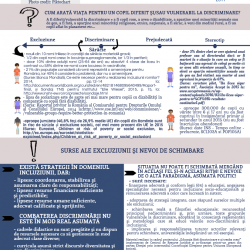Least Restrictive Environment
“Mrs. Thompson, the team is ready for you.” I stood up and made my way to the conference room filled with the eight experts that would determine my son’s educational program. As I entered and sat down in the parent chair, I realized that my knees were trembling.
This was not my first Individual Education Plan (IEP) meeting. In fact I had been in hundreds, but never as a parent. I had always worn the hat of the special educator. Now I was the mom and I found that the parent chair was a far more frightening place. I was the one trying to find out all I could about diagnosis and prognosis. I was the one worried that my boy wouldn’t get everything he needed to reach his potential.
I was fortunate. I was negotiating in a system that had a legal mandate to give my child a full education that offered services and accommodations to help him be successful. As a professional in that very system I knew that there were flaws and that the programming and resources were far from perfect (a reality in any human endeavor), yet I also knew that I was working with a team in a school system dedicated to treating my son with compassion and fairness. At the end of our long meeting I left with my son’s IEP, 35 pages of detailed plans outlining his educational program. As I signed the document and expressed my appreciation to the team, the meeting chair said something I’ve never forgotten. “Fair is not everyone getting the same thing. Fair is everyone getting what they need in order to succeed.”
That was the first of many IEP meetings that I attended for my son and then my daughter. Each of those meetings had the same primary objective; giving my children the support and accommodation that they needed in order to perform academically in the Least Restrictive Environment (LRE). In the United States, the Individual with Disabilities Education Act (IDEA) passed in 1975. IDEA states that children who receive special education services should learn in the least restrictive environment. This means that they should spend as much time as possible with peers who do not receive special education.
IDEA specifies two conditions for LRE:
- A student should be with children in the general education environment to the “maximum extent that it is appropriate.”
- Removing a child from the general education classroom should only occur when his or her learning disability is so severe that supplementary aids and services cannot provide desired educational outcomes.
A key word here is “appropriate.” It refers to what is suitable for the individual child. Sometimes putting a child in a general education classroom full time is not suitable because it is not optimal for learning. While a general education classroom is always the ultimate goal, some children require a smaller class size or instructional strategies that a typical classroom cannot provide. In order to learn at the desired pace these children are given a more restrictive and specialized setting during some or all of the school day.
When LRE is discussed, often so are the words “mainstreaming” and “inclusion.” They mean different things. A mainstream classroom is a general education classroom. Mainstreaming means putting a child with special education needs into the typical classroom setting. This word is being used less and less often because it is giving way to the much better practice of inclusion.
An inclusion classroom is a general education classroom that accommodates students who receive special education services. It is an instructional and social emotional approach that allows all students regardless of learning differences a place in the school community. It goes well beyond the general education classroom. It aims to create a school community that includes all individuals not only in the academic classroom, but also in the arts, physical education, common room gatherings, and extra-curricular activities. Lisa Friedman, special educator and inclusion consultant says it best:
“Inclusion is a philosophy that embraces the idea that everyone has something of value to contribute and that everyone has a right to belong. “
Lisa Friedman
IDEA left LRE open to interpretation. It does not specify a certain environment for a specific disability or learning style. Each child is unique and will have a unique plan for optimal learning. There is a continuum of options that are available and each child in special education is given placement in or within the following options:
- General Education Classroom
- Accommodation/supplementary aids
- In-class supplementary service
- Resource class/partial day
- Self-contained classroom in neighborhood school
- Private/specialized school (increasingly rare)
- Hospital/Home for children with chronic or severe illnesses
LRE takes time and expertise to determine and is reviewed every school year. There is a team of people who make these decisions. They are:
- Parent (Nothing can be decided or implemented without parental input and approval)
- Student (Students at the secondary level often take part in the meeting)
- Special Educator
- General Educator
- Therapist/ Speech, OT, PT
- Psychologist
- School/District Leadership
This team forms the Individual Education Plan (IEP) document. This vital document is a legal contract between the family and the educational institution. Some of the points of agreement include the following:
- Identification of strengths- needs
- Current levels of performance or development
- Goals and Objectives
- Percentage of time in specific settings/classrooms and therapy
- Behavior/Sensory/Motivation/Communication plan if appropriate
- Transportation plan
- Academic placement
This IEP will be reviewed and updated annually. However if the parent or others on the team feel that it is inappropriate or outdated during the school year, the team can convene to update or adapt.
Advanced training is clearly needed for all of those in the special education team. A sound knowledge of development, disabilities, alternative instruction, inclusion practices, and therapeutic interventions are critical for those making and implementing these decisions.
While none of these processes are easy, each child deserves the opportunity to reach his or her academic potential. I have had different roles at many IEP tables, as parent and as professional. As a professional I know that making the right decisions regarding LRE impacts a child’s learning and life trajectory for better or worse. As a parent I worked with and depended on the dedicated professionals supporting my children. My son and daughter are now succeeding in the PhD and undergraduate university level because of the support they were given in the primary and secondary
levels. All societies must invest in the education of each and every one of our children. We all benefit.
by Jane Krill Thompson
Jane Krill Thompson has 25 years of experience supporting families and their children with special needs. In the United States, she has worked with the Montgomery County Public Schools in the Infant and Toddler Program, the Preschool Education Program, and Adult Education.
While abroad, she has had the opportunity to work with numerous NGOs, intervention programs, and International Schools. Jane is a qualified examiner in the area of developmental assessments and has expertise in child development, early intervention strategies, and parent coaching.
She provides consultations, seminars and workshops for parents and educational staff. She has a BS in Child Development and an MS in Early Childhood Special Education and Early Intervention. She is currently serving as Chair of the Board of Trustees at the American International School of Bucharest.
Jane is Project Coordinator for the Parent Skills Training Project sponsored in partnership with Autism Speaks and the World Health Organization and also serves on the Advisory Board of the Ovidiu Ro foundation and the Romanian Finlandia School. Jane and her husband, Dean, a Senior Foreign Service Officer, have three children.










2 Responses